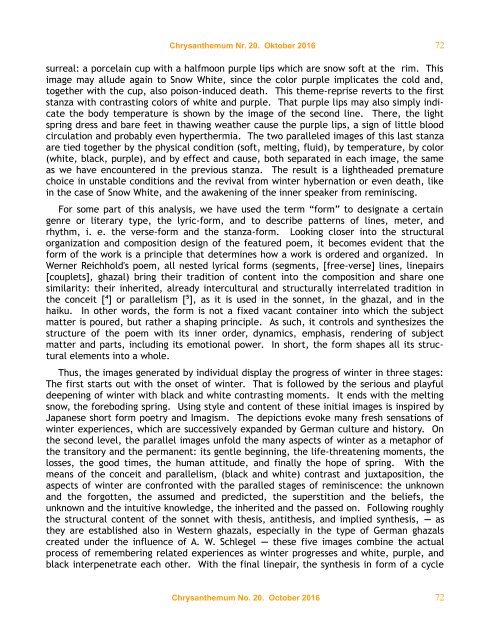Internet-Magazin Internet Magazine
1G26s1kkG
1G26s1kkG
Sie wollen auch ein ePaper? Erhöhen Sie die Reichweite Ihrer Titel.
YUMPU macht aus Druck-PDFs automatisch weboptimierte ePaper, die Google liebt.
Chrysanthemum Nr. 20. Oktober 2016 72<br />
surreal: a porcelain cup with a halfmoon purple lips which are snow soft at the rim. This<br />
image may allude again to Snow White, since the color purple implicates the cold and,<br />
together with the cup, also poison-induced death. This theme-reprise reverts to the first<br />
stanza with contrasting colors of white and purple. That purple lips may also simply indicate<br />
the body temperature is shown by the image of the second line. There, the light<br />
spring dress and bare feet in thawing weather cause the purple lips, a sign of little blood<br />
circulation and probably even hyperthermia. The two paralleled images of this last stanza<br />
are tied together by the physical condition (soft, melting, fluid), by temperature, by color<br />
(white, black, purple), and by effect and cause, both separated in each image, the same<br />
as we have encountered in the previous stanza. The result is a lightheaded premature<br />
choice in unstable conditions and the revival from winter hybernation or even death, like<br />
in the case of Snow White, and the awakening of the inner speaker from reminiscing.<br />
For some part of this analysis, we have used the term “form” to designate a certain<br />
genre or literary type, the lyric-form, and to describe patterns of lines, meter, and<br />
rhythm, i. e. the verse-form and the stanza-form. Looking closer into the structural<br />
organization and composition design of the featured poem, it becomes evident that the<br />
form of the work is a principle that determines how a work is ordered and organized. In<br />
Werner Reichhold's poem, all nested lyrical forms (segments, [free-verse] lines, linepairs<br />
[couplets], ghazal) bring their tradition of content into the composition and share one<br />
similarity: their inherited, already intercultural and structurally interrelated tradition in<br />
the conceit [ 4 ] or parallelism [ 5 ], as it is used in the sonnet, in the ghazal, and in the<br />
haiku. In other words, the form is not a fixed vacant container into which the subject<br />
matter is poured, but rather a shaping principle. As such, it controls and synthesizes the<br />
structure of the poem with its inner order, dynamics, emphasis, rendering of subject<br />
matter and parts, including its emotional power. In short, the form shapes all its structural<br />
elements into a whole.<br />
Thus, the images generated by individual display the progress of winter in three stages:<br />
The first starts out with the onset of winter. That is followed by the serious and playful<br />
deepening of winter with black and white contrasting moments. It ends with the melting<br />
snow, the foreboding spring. Using style and content of these initial images is inspired by<br />
Japanese short form poetry and Imagism. The depictions evoke many fresh sensations of<br />
winter experiences, which are successively expanded by German culture and history. On<br />
the second level, the parallel images unfold the many aspects of winter as a metaphor of<br />
the transitory and the permanent: its gentle beginning, the life-threatening moments, the<br />
losses, the good times, the human attitude, and finally the hope of spring. With the<br />
means of the conceit and parallelism, (black and white) contrast and juxtaposition, the<br />
aspects of winter are confronted with the paralled stages of reminiscence: the unknown<br />
and the forgotten, the assumed and predicted, the superstition and the beliefs, the<br />
unknown and the intuitive knowledge, the inherited and the passed on. Following roughly<br />
the structural content of the sonnet with thesis, antithesis, and implied synthesis, — as<br />
they are established also in Western ghazals, especially in the type of German ghazals<br />
created under the influence of A. W. Schlegel — these five images combine the actual<br />
process of remembering related experiences as winter progresses and white, purple, and<br />
black interpenetrate each other. With the final linepair, the synthesis in form of a cycle<br />
Chrysanthemum No. 20. October 2016 72


